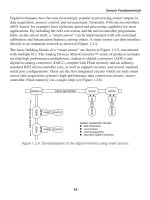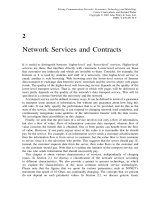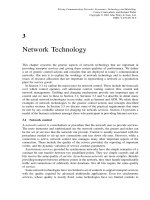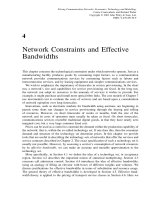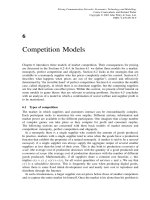Tài liệu Pricing communication networks P2 ppt
Bạn đang xem bản rút gọn của tài liệu. Xem và tải ngay bản đầy đủ của tài liệu tại đây (151.6 KB, 17 trang )
2
Network Services and Contracts
It is useful to distinguish between ‘higher-level’ and ‘lower-level’ services. Higher-level
services are those that interface directly with customers. Lower-level services are those
that customers use indirectly and which are invisible to them. Consider, for example, the
Internet as it is used by students and staff of a university. One higher-level service is
email; another is web browsing. Web browsing uses the lower-level service of Internet
data transport to exchange data between users’ terminals and the servers where web pages
reside. The quality of the higher-level web browsing service depends on the quality of the
lower-level transport service. That is, the speed at which web pages will be delivered to
users partly depends on the quality of the network’s data transport service. This will be
specified in a contract between the university and the network.
A transport service can be defined in many ways. It can be defined in terms of a guarantee
to transport some amount of information, but without any guarantee about how long this
will take. It can fully specify the performance that is to be provided, and do this at the
start of the service. Alternatively, it can respond to changing network load conditions, and
continuously renegotiate some qualities of the information transfer with the data source.
We investigate these possibilities in this chapter.
Finally, we note that the provision of a service involves not only a flow of information,
but also a flow of value. Flow of information concerns data transport, whereas flow of
value concerns the benefit that is obtained. One or both parties can benefit from the flow
of value. However, if one party enjoys most of the value it is reasonable that he should
pay for the service. For example, if an information server sends a customer advertisements
then the information flow is from server to customer, but the value flow is from customer
to server, since it is the advertiser who profits. This suggests that the server should pay. If,
instead, the customer requests data from the server, then value flows to the customer and
so the customer should pay. Note that it is neither the initiator of the transport service, nor
the one who sends information that should necessarily pay.
This chapter is about various characteristics of services, independently of charging
issues. In Section 2.1 we discuss a classification of the network services according
to different characteristics. We also provide a primer to present technology, in which
we explain the characteristics of the most common network service technologies.
Please note that the figures that we quote for various parameters, such as SONET’s
maximum line speed of 10 Gbps, are continually changing. The concepts that we present
do not depend on such parameter values. In Section 2.2, we discuss generic issues
Pricing Communication Networks: Economics, Technology and Modelling.
Costas Courcoubetis and Richard Weber
Copyright
2003 John Wiley & Sons, Ltd.
ISBN: 0-470-85130-9
24 NETWORK SERVICES AND CONTRACTS
related to contracts for network services, focusing on issues of quality of service and
performance.
2.1 A classification of network services
At its most basic level a network provides services for transporting data between points in
the network. The transport service may carry data between just two points, in which case
we have a unicast service. Or it may carry data from one point to many points, in which
case we have a multicast service.
The points between which data is carried can be inside the network or at its periphery.
When a web server connects with a user’s browser then both points are at the periphery.
When an access service connects a customer’s terminal equipment to the network of
a different service provider then the customer’s point is at the periphery and the
point connecting to the different service provider’s network is inside. When a network
interconnects with two other networks then both points are inside. Thus network operators
can buy or sell transport services amongst themselves and collaborate to provide transport
services to end-points residing on different networks. We see all these things in the Internet.
For simplicity, we often refer to a large collection of cooperating networks that provide a
given transport service as ‘the network’.
2.1.1 Layering
Service layering is common in communication networks. A higher layer service consumes
lower layer services and adds functionality that is not available at the lower layers. Services
of various layers can be sold independently, and by different service providers. An example
of a higher layer service is an end-to-end transport service that connects customer equipment
at two periphery points of the network. This service uses lower layer services, some of which
are strictly internal to the network; these lower layer services provide connectivity between
internal nodes of the network and the access service that connects the users’ equipment to
the network. The end-to-end service may perhaps add the functionality of retransmitting
information lost by the lower-level services.
A simple analogy can be made by considering a network of three conveyor belts. One
connects node A to node B. Two others connect node B to nodes C and D. Suppose that
each conveyor belt is slotted and provided with fixed size bins that move with the belt.
Parcels are inserted into the bins so that they do not fall off the belts while travelling. In
order to provide an end-to-end service from A to C and D, some additional functionality
is needed. For instance, bins travelling between A and B might be coloured red and blue.
Parcels arriving in a red bin at node B are assigned by a clerk to continue their journey on
the conveyor belt from B to C, whereas parcels in the blue bins continue on the conveyor
belt from B to D. Clerks are needed to read the destination addresses, fill the different
colour bins on the conveyor belt, and empty the bins that arrive at nodes C and D. Of
course there are other ways to build the same end-to-end service, for instance, we could
use bins of just one colour on the belt from A to B, but have a clerk at node B check
the destination address of each arriving parcel to decide whether it should next be placed
on belt BC or BD. A key feature of this setup is the layering of services: one or more
companies may provide the basic conveyor services of conveyor belts AB, BC and BD,
while another company provides and manages the bins on top of the conveyor belts. Yet
another company may provide the service of filling and emptying the bins (especially
A CLASSIFICATION OF NETWORK SERVICES 25
if bins are a single colour and the destination address of the parcels must be checked
at point B). Thus, our setup has three layers of service. The first layer is the conveyor
service AB. In Internet terms it is analogous to an access service, which connects the
equipment of customer A to the network B by, say, a dial-up connection. Typically, an
Internet service provider provides the other two layers of service (of running the conveyors
internal to the network, and managing and filling the bins on the conveyors, including
the access part). Sometimes, a third party provides all three layers of service in the
access part.
Let us illustrate these concepts in more depth by briefly describing transport service
layering in an actual example from the current Internet. We view the Internet as a single
network using layers of different technologies. Further treatment of these services is
provided in Section 3.3.
2.1.2 A Simple Technology Primer
The basic Internet transport service carries information packets between end-points of the
Internet in much the same way as the post office delivers letters. Letters that are going to
the same city are sorted into large mail bags, which are loaded onto airplanes, and then
delivered to a central point in the destination city. The letters are then regrouped into the
smaller mail bags that postmen can carry on their routes.
Just as the post office uses airplanes, vans and foot, and different size containers and mail
bags, so Internet transport service uses many different transport technologies. These include
Ethernet, Asynchronous Transfer Mode (ATM), Synchronous Digital Hierarchy (SDH),
Synchronous Optical Network (SONET), and Dense Wavelength Division Multiplexing
(DWDM). These technologies are described in Sections 3.3.2–3.3.5. We introduce the basic
technologies in an informal way that motivates their particular use.
For the moment, we emphasize the fact that each of the above technologies provides
a well-defined transport service and packages information in different size packets. The
packets of one service may act as containers for packets of another service. Suppose, for
simplicity, that the post office transports fixed size packets between customers. A transport
company provides a container service between local post offices at A and B by running
small vans of fixed capacity at regular intervals between A and B. Prior to the departure
of a van from A, the local post office fills the van with the packets that are waiting to be
delivered to the post office at B. Such a service is a paradigm of a synchronous container
service, since it operates at regular intervals and hence offers a fixed transport capability
between point A and B. The SONET or SDH services are examples of synchronous services
in communications networks.
If each van can hold at most k packets then the unit of information transfer between
points A and B is a container of size k. If a van departs every t seconds, then the capacity
of the container service is k=t packets per second. (For data, we measure capacity in bits
per second, or kilobits, Megabits or Gigabits per second.) Observe that containers may not
be filled completely, in which case the extra space is wasted. We can extend this type of
synchronous container service by supposing that the transport company uses larger vans, of
container size 10k, again leaving every t seconds. These containers can be filled by smaller
‘subcontainers’ of sizes that are multiples of k, and customers can rent such space in them
(provided that the sum of the sizes of the subcontainers does not exceed 10k). The post
office could obtain the same service as before by renting a subcontainer service of size k.
Similarly, an operator running a 622 Mbps SONET service between points A and B can
26 NETWORK SERVICES AND CONTRACTS
sell four distinct 155 Mbps SONET connections between these points (after reserving two
of the 622 Mbps to control the connection).
What happens if customers cannot effectively fill the smallest size subcontainers? Say
the post office traffic between points A and B has a maximum rate of 0:5k=t packets per
second, and so can justify using containers of size at most 0:5k, but there are other potential
customers who can also use fractions of k. Then there is a business opportunity for another
operator, who buys the k container size service from the original operator and reserves
space in each such container for his customers. This is a ‘value-added’ service, in the sense
that he may reserve a different maximum amount of space for each customer, fill the unused
space of one customer with excess traffic of another customer, and is able to distinguish
packets belonging to different customers when the container is unpacked. The equivalent
of this ‘smart container packing’ service is an ATM virtual path service. A simple case of
container packing is to reserve a fixed portion of the space to each customer. For instance,
an ATM service provider using the 155 Mbps SONET service between points A and B,
can provide two independent ATM virtual path connections of sizes 55 and 100 Mbps that
may be sold to different customers. Basically, he can flexibly construct any number of such
fixed bandwidth bit pipes based on the actual demand. Again notice that a customer such
as the post office which buys the above fixed bandwidth service may not fill the capacity of
the service at all times. There are more interesting ways that ATM can pack the containers
to avoid unused space. In these cases, the virtual paths do not have a fixed static size but
can dynamically inflate or deflate according to the actual number of packets that are being
shipped.
In the above, the post office plays an analogous role to IP. Since the local post office at
B may not be the final destination of a packet, but only an intermediary, the post officer
at B must look at each packet in turn and decide whether to deliver it locally or forward
it to another post office location. This is the functionality of the IP protocol: to distinguish
packets belonging to different customers and deliver them or route them effectively through
the other ‘IP post offices’. A customer delivering packets at random irregular intervals to
the IP post office (destined for some other customers) views the IP service as building a
flexible ‘packet pipe’ through the network that does not reserve some predetermined amount
of bandwidth. Note that such connections may have highly variable durations, and their
end-points may be unpredictable as far as the IP service is concerned.
In its turn, the IP service provider can sell a number of such packet connections between
points A and B (or the capability for activating such connections), by making certain that
there is only a small probability of completely filling the fixed bandwidth service that he
purchases from the ATM service provider between A and B. Now statistics come into play.
Since most of the time only a small number of the IP connections will be sending packets
simultaneously, say a fraction p of the total number n, he needs only enough bandwidth
between A and B to accommodate pn sources, assuming that these send continuously. Note
the large saving in bandwidth compared to what he would need if he were to reserve the
maximum bandwidth needed by each source, that is, enough bandwidth for n such sources
instead for pn. This controlled overbooking is an effect of statistical multiplexing discussed
in Section 4.2. It is important to observe that fixed bandwidth services can be used for
achieving the reverse effect of flow isolation. For instance, if the IP service needs to assign
dedicated bandwidth for a packet connection between A and B, then rather than mixing
these packets with IP packets from other connections in the same containers, it can purchase
a dedicated container service, solely for carrying the packets it wishes to isolate. Such flow
isolation may be used to guarantee good performance, since shared containers have fixed
A CLASSIFICATION OF NETWORK SERVICES 27
ATM virtual path
IP flows
SONET connection
Light path
Figure 2.1 A transport service layering hierarchy. Light paths and SONET (SDH) provide large
synchronous bit pipes. ATM further divides these pipes, and allows connections to use capacity that
is temporarily unused by other connections. IP is used to establish connections between arbitrary
network end-points, of unpredicted duration and intensity.
size and packets may have to queue at the IP stations to find free space in containers. This
congestion effect is reduced by offering such an exclusive treatment, but comes at an extra
cost. We are ready now to proceed with the Internet analogy.
In the late 1990s, many parts of the Internet were implemented as IP over ATM. ATM can
run over SDH (or SONET), which in turn can run over an optical network. This transport
service layering is shown in Figure 2.1.
More specifically, an optical network technology provides a point-to-point synchronous
‘container’ service, such as SONET operating at a maximum steady rate of 10 Gbps. In turn,
SONET provides subcontainer transport services with rates that are multiples of 155 Mbps.
ATM is used to provide flexible partitioning of such large SONET containers for services
that require fractions of this bandwidth. IP is responsible for packing and unpacking the
fixed size bandwidth services provided by ATM into information streams consisting of
variable size objects (the IP packets produced by user applications), whose resulting bit
rates are much smaller and bursty. IP is a multiplexing technology that ‘buys’ such fixed
size bandwidth services and makes a business of efficiently filling them with information
streams that are variable in both the rate and size of packets. Thus, IP and ATM can be
viewed as ‘retailers’ of ‘wholesale’ services such as SONET.
Different parts of the overall network may be connected with different container
technologies. The idea is to choose a technology for each link whose container size
minimizes wasted space in partially packed containers. In the interior of the network many
traffic streams follow common routes and so it makes sense to use large containers for
links on these routes. However, at the periphery of the network it makes sense to use small
containers to transport traffic from individual sources. Thus the business of a network
operator is to provide connectivity services by choosing appropriately sized containers for
the routes in his network, and then to efficiently pack and unpack the containers. The
Internet transport service efficiently fills the large fixed size containers of the lower-level
services and connects two end-points by providing a type of connecting ‘glue’.
Example 2.1 (IP over ATM over SONET) A concrete example of transport service
layering is shown in Figure 2.2. In this figure Provider 1 aims to fill completely his
622 Mbps container service between points K and L. He may be buying a light path
service from a provider who owns the fibre infrastructure between the above points, in
which the container service could run up to 10 Gbps. He fills his containers by selling
28 NETWORK SERVICES AND CONTRACTS
IP packets
A
622 Mbps containers (SONET)
B
F
L
H
E
GK
C
D
100 Mbps ATM VP service
155 Mbps containers (SONET)
55 Mbps ATM VP service
Provider 1: network K−L, Provider 2: network G−H, Provider 3: network E−F
Figure 2.2 An example of transport service layering. Transport service Provider 1 operates a
622 Mbps SONET service between points K and L and sells 155 Mbps SONET services to
customers. Provider 2 runs an ATM over SONET network with nodes G, H , and sells a 100 Mbps
ATM service between points E and F to Provider 3; to do this he buys a 155 Mbps SONET service
for connecting G and H from Provider 1. Provider 3 sells IP connectivity service to customers A,
B, C and D by connecting his routers E and F using the 100 Mbps ATM service
bought from Provider 2.
smaller container services, in sizes that are multiples of 155 Mbps, such as that which
connects nodes G and H of Provider 2. Provider 3 sells Internet services to his customers
and runs a two node IP network between routers at E and F. In doing this, he must connect
these nodes so that they can exchange Internet data. This data is packaged in variable size
IP packets and is sporadic, with a total rate not exceeding 100 Mbps. To connect E to F
he buys a 100 Mbps ATM Virtual Path (i.e. a 100 Mbps bit pipe) from Provider 2. Provider
2 uses the ATM technology to subdivide the 155 Mbps SONET container service between
G and H, and so sell finer granularity bandwidth services. For instance, he fills the rest of
the 155 Mbps containers traversing the F to G link by selling a 55 Mbps ATM connection
to some other customer. Note that if Provider 3 has enough Internet traffic to fill 155 Mbps
containers, he can buy a pure SONET service between points E and F, if available. This
is what happens in IP over SONET. If he has even more traffic, then he can buy a light
path service to connect the same points, which is IP over ½. Such a service may provide
for 10 Gbps of transport capability for IP packets.
Note that bitrate is not the only differentiating factor among transport services. The
IP network E–G allows any pair of customers amongst A; B; C and D to connect for
arbitrarily short times and exchange data without the network having to configure any such
connections in advance. By contrast, SONET (and ATM) are used for specific point-to-point
connections that have a much longer lives.
Finally, each service that is sold to a customer has initial and final parts that give access
to the provider’s network. For instance, in order to run the ATM service between E and F
one must connect E to G and H to F. This access service may be provided by Provider 2
himself or bought from some third provider. Similarly, IP customer A must use some access
service to connect to the IP network of Provider 3.
2.1.3 Value-added Services and Bundling
Some services provide much more than simply a data transport service. Consider a web
service. It provides a data transport service, but also a data processing service and a data
presentation service. The latter two services add value and belong to a layer above that
